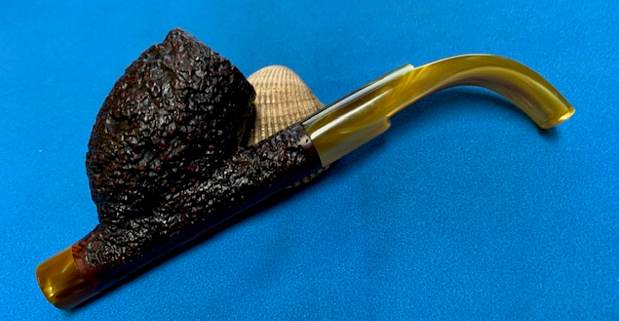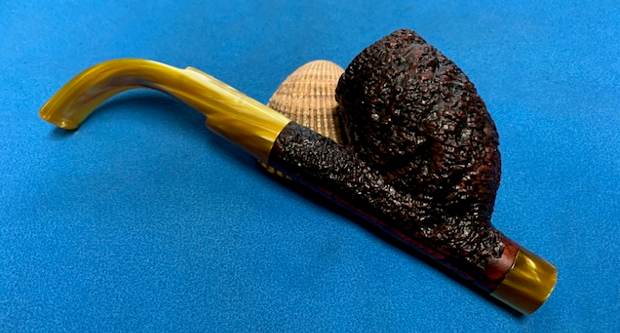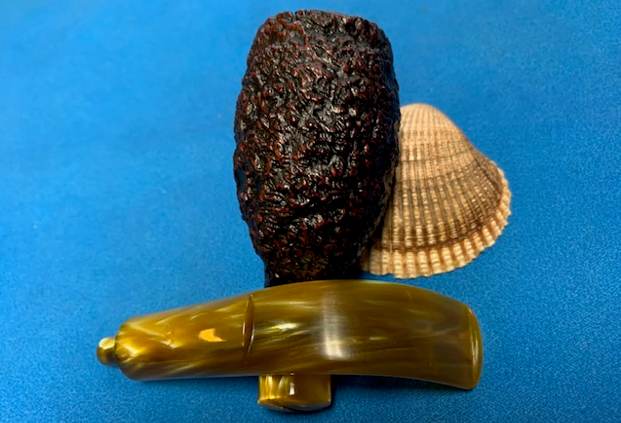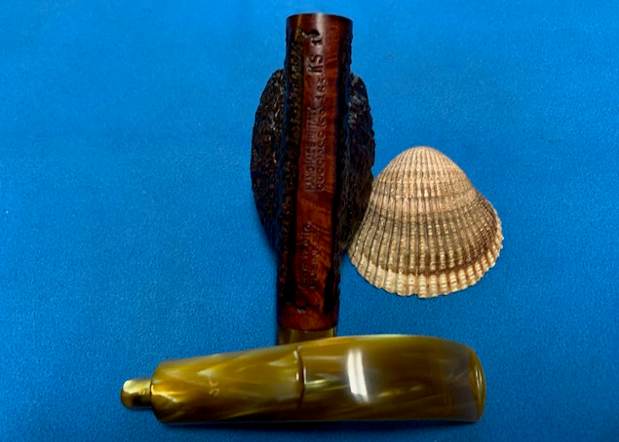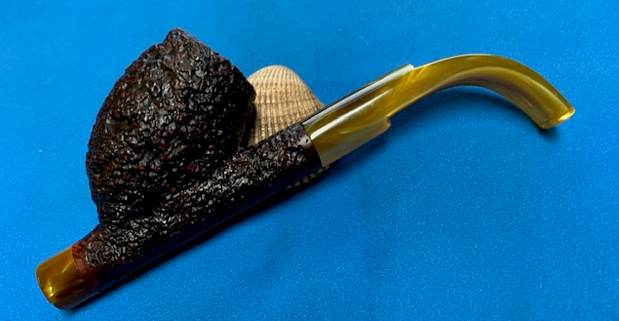Blog by Steve Laug
The next pipe on my worktable is a Caminetto Business Pipe was purchased on 03/30/22 from Plano, Texas, USA. It is a beautiful rusticated Cavalier with an acrylic end cap on the shank and an acrylic saddle stem. It was a good looking pipe but it was filthy with grime and oils ground into the rusticated finish on the bowl. The pipe had some rustic beauty shining through the dust and debris in the valleys of the rough finish. The rustication covered the rim top, bowl and shank with a smooth panel on the underside of the shank. The finish was dull and lifeless and dirty from sitting around. There was a very thick cake in the bowl with lava flowing out of the bowl and over the rim top. The lava had filled in the deeper grooves of the rusticated finish on the rim top. The inner edge of the rim appeared to be in good condition but it was hard to tell under the thick lava. The stamping on the underside of the shank read “CAMINETTO [over] BUSINESS”. To the right of that toward the stem it was stamped HAND MADE IN ITALY [over] CUCCIAGO (CO). That was followed by the shape number 185 and KS1. The golden variegated acrylic saddle stem had light tooth chatter and a few deeper tooth marks on both sides near the button. Jeff took the following photos before he started his cleanup work on the pipe. He took close-up photos of the bowl and rim top from various angles to capture the condition of the bowl and rim top edges. You can see the lava overflow and debris in the rustication of the rim top. You can see the cake in the bowl. This was a dirty pipe but it was the finish was in great condition. The next photos show the overview of the stem and the fit in the rusticated shank end as well as the light tooth chatter and a few deeper marks on the top and underside of the stem.
He took close-up photos of the bowl and rim top from various angles to capture the condition of the bowl and rim top edges. You can see the lava overflow and debris in the rustication of the rim top. You can see the cake in the bowl. This was a dirty pipe but it was the finish was in great condition. The next photos show the overview of the stem and the fit in the rusticated shank end as well as the light tooth chatter and a few deeper marks on the top and underside of the stem.

 He took photos of the sides and heel of the bowl to show the beautiful incredibly deep rustication around the bowl. It is the same kind of rough rusticated finish that I really like on Castello Sea Rock pipes. You can see the oil, dust and debris in the finish on both sides of the bowl.
He took photos of the sides and heel of the bowl to show the beautiful incredibly deep rustication around the bowl. It is the same kind of rough rusticated finish that I really like on Castello Sea Rock pipes. You can see the oil, dust and debris in the finish on both sides of the bowl. 

 Jeff took photos of the stamping on the shank. It reads as noted above. The stamping is clear and readable.
Jeff took photos of the stamping on the shank. It reads as noted above. The stamping is clear and readable.
 I turned to Pipephil (http://www.pipephil.eu/logos/en/logo-c1.html) to see if he included not only information on this Caminetto Business 182. He gave some interesting information about the brand. It was created in 1986 by Guiseppe Ascorti, Luigi Radice and Gianni Davoli as the distributor. It states that in 1979 the first Caminetto period ended with Luigi Radic leaving the company. Guiseppe Ascorti continued making the pipe with his son Roberto. In 1986 the New Caminetto period began by Roberto Ascorti.
I turned to Pipephil (http://www.pipephil.eu/logos/en/logo-c1.html) to see if he included not only information on this Caminetto Business 182. He gave some interesting information about the brand. It was created in 1986 by Guiseppe Ascorti, Luigi Radice and Gianni Davoli as the distributor. It states that in 1979 the first Caminetto period ended with Luigi Radic leaving the company. Guiseppe Ascorti continued making the pipe with his son Roberto. In 1986 the New Caminetto period began by Roberto Ascorti. I turned to Pipedia for more information on the Caminetto and how to date the pipe I had in hand (https://pipedia.org/wiki/The_History_of_Caminetto_(shapes,_stamping,_articles,_etc.). I quote a pertinent paragraph:
I turned to Pipedia for more information on the Caminetto and how to date the pipe I had in hand (https://pipedia.org/wiki/The_History_of_Caminetto_(shapes,_stamping,_articles,_etc.). I quote a pertinent paragraph:
 Stampings and dating: First off, dating earlier Caminetto’s is nearly impossible. Nevertheless, there were three phases, some in which were much earlier, of development that occurred in the stamping process of Caminetto. Before that though, every pipe had the stamp of Caminetto in one of two ways: Caminetto in script or Caminetto within quotation marks in block letters (I do not know how it was decided which pipe got which stamp, as I have had EARLY Caminetto’s with both)…
Stampings and dating: First off, dating earlier Caminetto’s is nearly impossible. Nevertheless, there were three phases, some in which were much earlier, of development that occurred in the stamping process of Caminetto. Before that though, every pipe had the stamp of Caminetto in one of two ways: Caminetto in script or Caminetto within quotation marks in block letters (I do not know how it was decided which pipe got which stamp, as I have had EARLY Caminetto’s with both)…
The stampings are shown in the photo to the left. The stamping on this pipe is like #2.
…Now, the question is which stamps are earlier and more likely to have been made by Ascorti and/or Radice. The answer is #1. The differences in #2 and #3 seem to be minute, as Cucciago is simply a suburb of Cantu. Pipes stamped like #1 are the most valuable Caminetto’s as they are the earliest production of the brand, as well as what some would claim the most perfect of Ascorti and Radice’s work. The last tidbit is, of course, debatable…
… There is also another factor in stamping, that is, which series the pipe falls in. The majority of Caminetto’s one sees are those of the “Business” series, which are stamped such with their collective shape (see photo of shapes below). Another stamp that sometimes follows the “Business” one is “KS,” which from what I know means “King-size” (this could be wrong, as there are pipes stamped with KS1, KS2, and KS3).
Now it was time to look at it up close and personal. Jeff had done an amazing job in removing all of the cake and the lava on the rim top. He had reamed the bowl with a PipNet Pipe Reamer and cleaned up the remnants with a Savinelli Fitsall Pipe Knife. He took the cake back to bare briar so we could check the walls for damage. He scrubbed the exterior of the bowl with Murphy’s Oil Soap and a tooth brush to remove the grime on the bowl and rim and was able to remove the lava and dirt. He cleaned out the interior of the bowl and shank with pipe cleaners, cotton swabs and alcohol until they came out clean. He cleaned the stem and the trap at the end of the shank with Soft Scrub to remove the grime on the exterior and cleaned out the airway with alcohol, cotton swabs and pipe cleaners. I took photos of the pipe before I started my part of the restoration.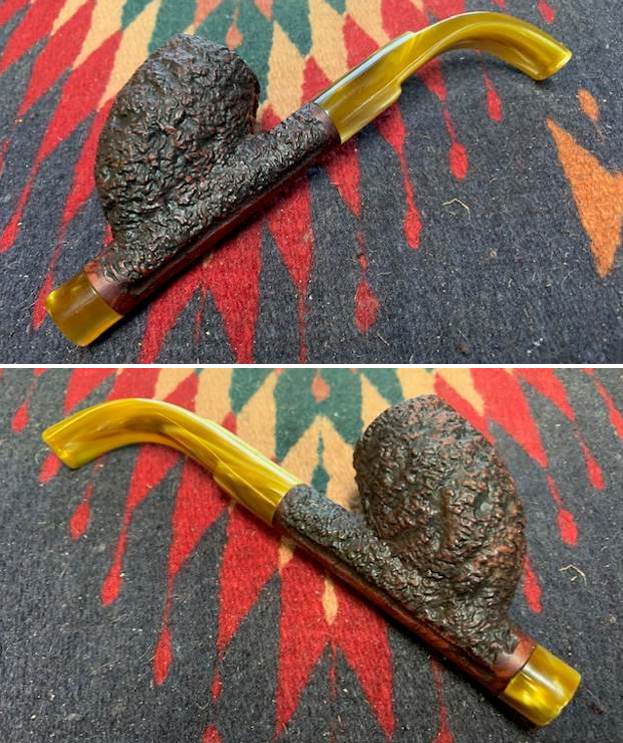
 To show how clean the rim top and stem really was I took a close-up photo of the rim and stem. The bowl was clean and cake free. The rim top is very clean with no residual lava buildup in the rusticated finish. The inner edges of the bowl look good. The golden acrylic saddle stem cleaned up nicely. The surface had some light tooth marks but the button edge looked really good.
To show how clean the rim top and stem really was I took a close-up photo of the rim and stem. The bowl was clean and cake free. The rim top is very clean with no residual lava buildup in the rusticated finish. The inner edges of the bowl look good. The golden acrylic saddle stem cleaned up nicely. The surface had some light tooth marks but the button edge looked really good.  I took a photo of the stamping on the underside of the shank. You can see that is clear and readable as noted above.
I took a photo of the stamping on the underside of the shank. You can see that is clear and readable as noted above. I removed the stem from the shank and took a photo of the parts of the pipe to show the overall sized of the pipe. It is a great piece that combines the gold acrylic on the shank end cap and the stem with the rusticated finish on the bowl and shank.
I removed the stem from the shank and took a photo of the parts of the pipe to show the overall sized of the pipe. It is a great piece that combines the gold acrylic on the shank end cap and the stem with the rusticated finish on the bowl and shank.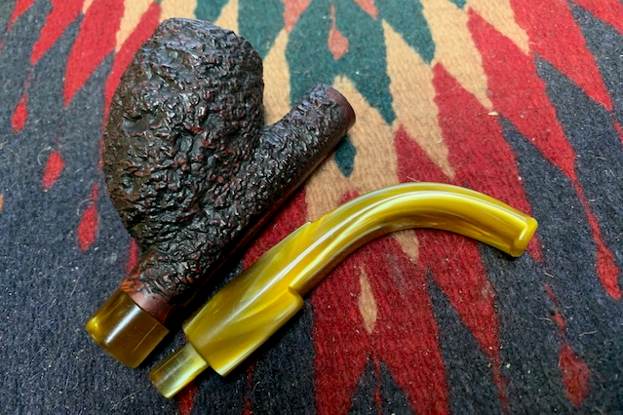 I started my work on the pipe by staining the areas on the rim top and rusticated finish were worn and faded. I used a Walnut stain pen to touch up the rim and around the top edge.
I started my work on the pipe by staining the areas on the rim top and rusticated finish were worn and faded. I used a Walnut stain pen to touch up the rim and around the top edge.  The bowl looked very good so I did not need to do any further work on it. I rubbed the bowl and shank down with Before & After Restoration Balm to deep clean the finish on the bowl and shank. The product works to clean, enliven and protect the briar. I worked it in with my fingers and with a horse hair shoe brush to get it into the nooks and crannies of the deep rustication of the finish on the bowl and shank. I let it sit for about 20 minutes to let it do its magic. I buffed it with a soft cloth. The briar really began to have a rich shine. I took some photos of the bowl at this point to mark the progress in the restoration.
The bowl looked very good so I did not need to do any further work on it. I rubbed the bowl and shank down with Before & After Restoration Balm to deep clean the finish on the bowl and shank. The product works to clean, enliven and protect the briar. I worked it in with my fingers and with a horse hair shoe brush to get it into the nooks and crannies of the deep rustication of the finish on the bowl and shank. I let it sit for about 20 minutes to let it do its magic. I buffed it with a soft cloth. The briar really began to have a rich shine. I took some photos of the bowl at this point to mark the progress in the restoration.

 I set the bowl aside and turned my attention to the stem. I filled in the deep tooth marks with clear CA glue. I sanded the repaired tooth marks and chatter smooth with 220 grit. I started polishing the whole stem with 600 grit sandpaper until the sanding marks were gone.
I set the bowl aside and turned my attention to the stem. I filled in the deep tooth marks with clear CA glue. I sanded the repaired tooth marks and chatter smooth with 220 grit. I started polishing the whole stem with 600 grit sandpaper until the sanding marks were gone. 
 I touched up the mustache stamp on the stem with Rub’n Buff Antique Gold. I applied it with a toothpick working it into the stamp. There were places on the sides of the stamp that were faint. I buffed it off with a soft cotton pad. It looked better.
I touched up the mustache stamp on the stem with Rub’n Buff Antique Gold. I applied it with a toothpick working it into the stamp. There were places on the sides of the stamp that were faint. I buffed it off with a soft cotton pad. It looked better.  I polished the stem on both sides using micromesh sanding pads. I dry sanded the stem with the 1500-12000 grit pads, then wiped it down with a cloth impregnated with Obsidian Oil. I finished polishing it with Before & After stem polish – both Fine and Extra Fine. I gave it a final coat of Obsidian Oil and set it aside to dry.
I polished the stem on both sides using micromesh sanding pads. I dry sanded the stem with the 1500-12000 grit pads, then wiped it down with a cloth impregnated with Obsidian Oil. I finished polishing it with Before & After stem polish – both Fine and Extra Fine. I gave it a final coat of Obsidian Oil and set it aside to dry.
 I put the Caminetto bowl and stem back together again and buffed them with Blue Diamond on the buffing wheel. I used a soft touch on the rusticated bowl so as not to fill it in with the polishing product. I gave the bowl several coats of Conservator’s Wax and the stem several coats of carnauba wax. I carefully buffed the entire pipe with a clean buffing pad to raise the shine. I finished buffing with a microfiber cloth to deepen the shine. The finished pipe looks very good. The rustication is very tactile and feels great in the hand. It is comfortable and light weight. The finished Caminetto Business 185 Cavalier is shown in the photos below. The dimensions of the pipe are Length: 7 inches, Height: 3 1/2 inches, Outside diameter of the bowl: 1 ¼ inches, Chamber diameter: 1 inch. The weight of the pipe is 63 grams/2.26 ounces. This great looking rusticated Caminetto turned out very well. It should be a great pipe. It will be going on the rebornpipes store in the Italian Pipe Makers Section shortly if you are interested in adding it to your collection. Thanks for reading this blog and my reflections on the pipe while I worked on it.
I put the Caminetto bowl and stem back together again and buffed them with Blue Diamond on the buffing wheel. I used a soft touch on the rusticated bowl so as not to fill it in with the polishing product. I gave the bowl several coats of Conservator’s Wax and the stem several coats of carnauba wax. I carefully buffed the entire pipe with a clean buffing pad to raise the shine. I finished buffing with a microfiber cloth to deepen the shine. The finished pipe looks very good. The rustication is very tactile and feels great in the hand. It is comfortable and light weight. The finished Caminetto Business 185 Cavalier is shown in the photos below. The dimensions of the pipe are Length: 7 inches, Height: 3 1/2 inches, Outside diameter of the bowl: 1 ¼ inches, Chamber diameter: 1 inch. The weight of the pipe is 63 grams/2.26 ounces. This great looking rusticated Caminetto turned out very well. It should be a great pipe. It will be going on the rebornpipes store in the Italian Pipe Makers Section shortly if you are interested in adding it to your collection. Thanks for reading this blog and my reflections on the pipe while I worked on it.